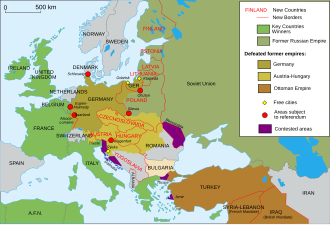
Irredentism is a political and popular movement in which its members claim, reclaim, and seek to occupy territory which they consider "lost", based on history or legend. The scope of this definition is occasionally subject to terminological disputes about underlying claims of expansionism, owing to lack of clarity on the historical bounds of putative nations or peoples.

The Axis powers, originally called the Rome–Berlin Axis, was a military coalition that fought in World War II against the Allies. The Axis powers agreed on their opposition to the Allies, but did not completely coordinate their activity.

United Nations trust territories were the successors of the remaining League of Nations mandates and came into being when the League of Nations ceased to exist in 1946. All of the trust territories were administered through the United Nations Trusteeship Council. The concept is distinct from a territory temporarily and directly governed by the United Nations.
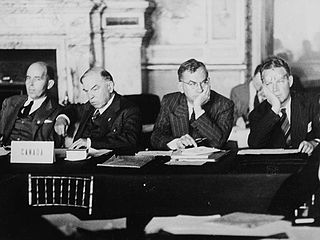
The Paris Peace Treaties were signed on 10 February 1947 following the end of World War II in 1945. The Paris Peace Conference lasted from 29 July until 15 October 1946. The victorious wartime Allied powers negotiated the details of peace treaties with Italy, Romania, Hungary, Bulgaria and Finland. The treaties allowed the defeated Axis powers to resume their responsibilities as sovereign states in international affairs and to qualify for membership in the United Nations.
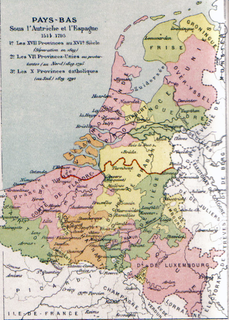
The Southern Netherlands, also called the Catholic Netherlands, was the part of the Low Countries largely controlled by Spain (1556–1714), later Austria (1714–1794), and occupied then annexed by France (1794–1815). The region also included a number of smaller states that were never ruled by Spain or Austria: the Prince-Bishopric of Liège, the Imperial Abbey of Stavelot-Malmedy, the County of Bouillon, the County of Horne and the Princely Abbey of Thorn. The Southern Netherlands were part of the Holy Roman Empire until the whole area was annexed by Revolutionary France.
Decolonization or decolonisation is the undoing of colonialism, the latter being the process whereby a nation establishes and maintains its domination of foreign territories. The concept particularly applies to the dismantlement, during the second half of the 20th century, of the colonial empires established prior to World War I throughout the world. Some scholars of decolonization focus especially on the movements in the colonies demanding independence, such as Creole nationalism.

The Treaty of Peace with Italy was signed on 10 February 1947 between Italy and the victorious powers of World War II, formally ending hostilities. It came into general effect on 15 September 1947.

Almost every country in the world participated in World War II. Most were neutral at the beginning, but only a relatively few nations remained neutral to the end. The Second World War pitted two alliances against each other, the Axis powers and the Allied powers; the Soviet Union had 35 million serving soldiers, the U.S 16 million, Germany 13 million and Japan 6 million. With millions serving in other countries, an estimated 300 million soldiers saw combat. A total of 72 million people died with the lowest estimate being 40 million dead and the highest estimate being 120 million dead. The leading Axis powers were Nazi Germany, the Empire of Japan and the Kingdom of Italy; while the United Kingdom, the United States and the Soviet Union were the "Big Three" Allied powers.
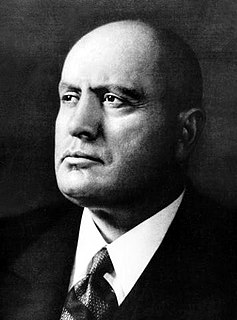
This timeline of events preceding World War II covers the events of the interwar period (1918–1939) after World War I that affected or led to World War II.
Territorial changes of the Baltic states refers to the redrawing of borders of Lithuania, Latvia and Estonia after 1940. The three republics, formerly autonomous regions within the former Russian Empire and before that of former Polish–Lithuanian Commonwealth, gained independence in the aftermath of World War I and the Russian Revolution of 1917. After a two-front independence war fought against both Bolshevist Russian and Baltic German nationalist forces, the countries concluded peace and border treaties with Soviet Russia in 1920. However, with World War II and the occupation and annexation of these republics into the Soviet Union twenty years after their independence, certain territorial changes were made in favour of the Russian SFSR. This has been the source of political tensions after they regained their independence with the dissolution of the Soviet Union. Some of the disputes remain unresolved.
The following is a list of the political history of East Africa.

The partition of the Ottoman Empire was a geopolitical event that occurred after World War I and the occupation of Constantinople by British, French and Italian troops in November 1918. The partitioning was planned in several agreements made by the Allied Powers early in the course of World War I, notably the Sykes-Picot Agreement, after the Ottoman Empire had joined the Ottoman–German Alliance. The huge conglomeration of territories and peoples that formerly comprised the Ottoman Empire was divided into several new states. The Ottoman Empire had been the leading Islamic state in geopolitical, cultural and ideological terms. The partitioning of the Ottoman Empire after the war led to the domination of the Middle East by Western powers such as Britain and France, and saw the creation of the modern Arab world and the Republic of Turkey. Resistance to the influence of these powers came from the Turkish National Movement but did not become widespread in the other post-Ottoman states until the period of rapid decolonization after World War II.
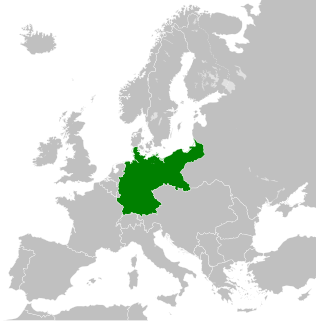
The territorial changes of Germany include all changes in the borders and territory of Germany from its formation in 1871 to the present. Modern Germany was formed in 1871 when Otto von Bismarck unified most of the German states, with the notable exception of Austria, into the German Empire. After the First World War, Germany lost about 10% of its territory to its neighbours and the Weimar Republic was formed. This republic included territories to the east of today's German borders.

The Italian colonial empire, known as the Italian Empire between 1936 and 1943, began in Africa in the 19th century. By 1936 it comprised the colonies, protectorates, concessions and dependencies of the Kingdom of Italy. In Africa, the colonial empire included the territories of present-day Libya, Somalia, Ethiopia and Eritrea. Outside Africa, Italy possessed the Dodecanese Islands off the coast of Turkey and a concession in Tianjin in China. Albania was a "de facto" Italian protectorate from 1917 to 1920 and from 1925 to 1939, when it was invaded and forced into a personal union with the kingdom of Italy. The Fascist government that came to power with Benito Mussolini in 1922 sought to increase the size of the Italian empire and to satisfy the claims of Italian irredentists. During World War II, Italy hesitated but then joined with Germany in 1940. In response, the Allies, especially Britain, seized the colonies in 1940–1943. In 1947, Italy officially relinquished claims on its former colonies. Only the territory of Somalia was eventually turned into a UN trust territory under Italian administration until 1960.
The decolonization of Asia was the gradual growth of independence movements in Asia, leading ultimately to the retreat of foreign powers and the creation of a number of nation-states in the region. A number of events were catalysts for this shift, most importantly the Second World War. Prior to World War II, some countries had already proclaimed independence.

The territorial evolution of Romania includes all the changes in the country's borders from its formation to the present day. The precedents of Romania as an independent state can be traced back to the 14th century, when the principalities of Wallachia and Moldavia were founded. Wallachia during its history lost several portions of its territory, either to the Ottomans or the Habsburgs. However, this land would be later essentially recovered in its entirety. Moldavia, on the other hand, suffered great territorial losses. In 1775, the Habsburgs invaded Bukovina and annexed it, and in 1812, the Russian Empire took control of Bessarabia. Both territories were later exposed to powerful colonization policies. The principalities declared unification in 1859 as the Principality of Romania. This new state sought independence from the Ottoman Empire's vassalage, and in 1878, it fought a war against it alongside Russia. However, the latter would annex Southern Bessarabia, which was recovered decades before. Romania received Northern Dobruja as compensation, and would wage a war for the southern part against Bulgaria in 1913.







